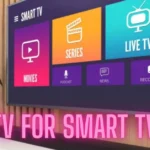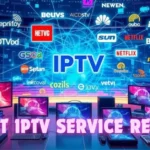
It is highly likely that you are unaware of abonnement IPTV Plus if you do not work in the media. It’s likely that you have been utilizing it for years, though. And in the future, you’ll probably use it even more. IPTV is a fast-growing industry. By 2029, experts predict the market value to have doubled—and then some. New companies and services are emerging, offering more IPTV Plus options alongside established TV providers. But what is IPTV? What does IPTV stand for? How does it work? You can apply it to enhance your experience of viewing TV. We’re here to walk you through the answers, starting with the basics.
What You’ll Learn
Utilize the following table of contents to go through this post:
- What IPTV is
- How IPTV works
- IPTV Services
- The future of IPTV
What Is IPTV Plus?
“Internet Protocol Television” is what IPTV stands for. It sounds technical, doesn’t it? But don’t let the name fool you. All IPTV actually does is use the Internet to broadcast television or video material to viewers. Unlike older, non-IPTV techniques like cable or satellite, that is.
Similar concepts apply whether you’ve used Netflix or Hulu, only in the case of TV programming rather than movies or syndicated series. And even if you don’t know it, you might already be using IPTV to watch live TV, catch-up TV, or VOD (Video on Demand). More on that later.
IPTV Plus vs. Non-IPTV: What’s the Difference?
The method by which your service provider distributes the material distinguishes IPTV from conventional non-IPTV. Active voice: Non-IPTV programming is delivered by radio signals from satellites or fibre-optic cables through pulses of light. However, you may receive the same content from IPTV Plus service providers over you’re broadband internet connection.
Why Do People Choose Internet Protocol Television?
Why would you pick IPTV if you could see the same content via a different distribution method? The main factor drawing a lot of people to IPTV is its greater flexibility. Let’s take a closer look at 03 ways this flexibility applies.
Flexibility On When You Watch
With cable or satellite TV, broadcasters send real-time signals, and viewers receive them. That means you’re only able to watch the broadcast live. You have no control over what is on and when unless you own a recording device. When possible, you tune in and take a look at what’s offered.
The most common IPTV formats are time-shifted media and video on demand (VOD); we’ll talk about those as a third format soon. Thus, IPTV allows you to continue watching your preferred TV program live. However, if you contact your provider in beforehand, they will send it to you right away, regardless of the live broadcast. The crux? Bid farewell to a strict TV schedule and the hassle of having to remember to set your DVR to record the shows you missed.
Flexibility on How You Watch
You don’t have to watch your favourite show live on TV when you have IPTV. On top of that, you do not have to stay glued to your TV screen… at all. The reason for this is that IPTV apps enable you to view episodes across many devices. This means you can play while in the kitchen by loading your favourite culinary show on your laptop, iPad, or smartphone. (Or wherever you choose!)
However, some more progressive cable companies even allow you to do this through an app. However, it’s not a guarantee.
Flexibility with The Network
In an IPTV context, all that means is a service provider is utilizing the internet protocol to communicate its television programming. Comparing old, one-sided cables connections or satellite broadcast networks to IP networks, which provide two-way interactivity within the network, reveals significantly more flexibility and possibilities. As the end-user, this allows you to Get more control and options to interact and personalize your experience.
Do You Need a Set-Top Box for IPTV Plus?
Yes and no. Let’s get into it.
If you have an older TV, it might not equipped for IPTV. You could require a set-top box in this situation, such as an Apple TV, Roku, or Amazon Fire TV. (These set-top boxes “convert” content that streams to your TV from the internet into a format that it can read.) To view IPTV, however, you don’t need anything other than your computer. any one of the IPTV forms (which we’ll cover next) can be used to livestream anything you want once you join up for a service.
Hybrid IPTV
Most TV Suppliers are now embracing a mixed approach to IPTV to alleviate some of the challenges with completely IP-enabled broadcasts. To send large amounts of data quickly, IPTV needs a sizable bandwidth. Traditional TV services are combined with IP-based ones in hybrid IPTV. One box that contains everything is the biggest selling point. That lets TV providers expand their offerings to their subscribers. Furthermore, it facilitates the introduction of new services and products without requiring a total redesign of the set-top box. In short, it’s the right way to transition from a traditional model to a more modern one.
How Does IPTV Plus Work?
There are 3 different IPTV formats. We will examine each one separately.
Video on Demand (VOD)
Video is delivered to you whenever you want it with VOD streaming. Movie-streaming sites are VOD services. Except for the content that the service currently holds rights to, there is no time restriction on what you can watch. It’s as simple as telling the services what’s you require to watch, having it sent to you over the Internet, and then watching it. VOD examples: Netflix, Hulu, and Amazon Prime Video are favoured examples of Over-The-Top (OTT) video streaming services. (In addition, there are numerous smaller, specialty services offered.)
Time-shifted media
This kind of IPTV is recognizable to anyone who have watched “catch-up TV.” Users can now catch up on missed episodes on many broadcast networks whenever it’s convenient for them. The shared content has a finite shelf life in time-shifted media, which is a key distinction from video on demand (VOD). One cannot rewatch an episode of a show that they missed years ago. Sure, but VOD would be needed for that. (If you think that VOD and time-shifted media sound a lot alike, you are right. The main factor is the amount of time you have to view a show once it premiers.) Time-shifted media example: BBC’s iPlayer is among the most widely used services that provides time-shifted media.
Live IPTV Plus
Similar to broadcast TV, IPTV offers live programming. Many people watch sporting events this way. That’s because streaming a game into your cell phone while driving is so easy. Live IPTV is essentially the same as traditional TV, except that it is aired online rather than through cable TV networks. Live IPTV options include CBS Sports HQ, FOX Sports Go, Sling TV, and Hulu Live TV.
IPTV Plus Services
Even while IPTV is growing, it remains a specialized industry. When the rights are acquired, streaming services like Hulu and Netflix provide a large selection of TV series. Additionally, the growth of media on demand is rapid. It is the other formats of IPTV Plus, there is a significant potential for changing how people watch Streaming, which has yet to take off. Catch-up TV is becoming more popular. NBC, FOX, CBS, and other providers’ apps can be downloaded to allow viewers to watch the programming they missed. Not to mention the work involved in setting up and recording content using a set-top box such as a TiVo. The live IPTV industry is being penetrated by TV Player, Epic stream, and NOW TV. Nonetheless, they’re still not as widely used as more well-known VOD services.
Where IPTV Services Have Grown
Sports seems to be the area of TV most quickly embraced IPTV. You can watch a plethora of sports packages that require a subscription on your computer or TV at any time. This is also evident in WWE’s historic agreement with Netflix. WWE’s flagship program, RAW, which presently broadcasts on the FR Network, is stepping away from standard cable programming after more than 30 years. It’s difficult to forecast the results of Netflix’s first foray into live streaming, considering the series wasn’t broadcast until January 2025. The deal shows potential for adding live TV broadcasts to VOD platforms for IPTV Plus. And if the arrangement goes well, it’s a good bet that the remainder of live television will follow suit. Additionally, a growing number of platforms are emerging that let individuals build their own live-streaming and VOD businesses. People can then share their knowledge, counsel, and passions with everybody on the planet.
Starting Your Own IPTV Service – IPTV Providers
Your best option if you want to launch your personal IPTV service is to sign up for one of these providers. They have the range, server capacity, and Distribution channels you need. To get started, simply select a plan, register, and begin uploading your content. What sort of content? Who will watch it? How will you make money? All of those things are up to you. You may find IPTV channels for viewing movies, learning how to dance, learning magic tricks, and almost every other activity you can think of. Short story: You can share content with everyone on the planet by using IPTV. Naturally, recording all that content will still be necessary, and it can be labour-intensive. Juice and squeeze can be equalized, though, if the IPTV platform and content match. Once you’ve completed that, you can quickly distribute and market your films, TV series, and online video material using these services.
The Future of IPTV
It’s challenging to estimate the number of users now utilizing IPTV services. With the wide variety of providers, different formats, and a large amount of pirated content available, there are many things to keep track of. Nonetheless, there’s no denying IPTV’s rising appeal. By 2029, Mordor Intelligence predicts the market to be valued at more than $105 billion. That exceeds the projected $44 billion market size for 2024 by more than twice. Grand View Research predicts that by 2027, the IPTV market will reach a valuation of more than $68 billion. According to Grand View, subscription-based IPTV is expected to grow rapidly over the next ten years, indicating a rise in popularity.
Some of that growth has started already.
- IPTV for Smart TV: The Ultimate Guide to Seamless Streaming in 2025
- Best IPTV Service UK: Top Providers, Features, and Complete Buyer’s Guide
- Best IPTV Service Free Trial in 2025: Ultimate Guide to Streaming Without Risks
- Best IPTV Service Reddit Users Recommend in 2025: Top Picks & Honest Reviews
- Best IPTV for Qatar: Everything You Need to Know in 2025
Conclusion
In an effort to rival streaming services like Amazon Prime, Netflix, and others, major media companies want to launch new offerings. Furthermore, longer-running TV networks facilitate time-shifted media through their apps. Customers of cable companies can even watch on their phones. Now that people can easily create channels to distribute their content, the quantity and variety of IPTV Plus options will enlarge quickly. Viewers won’t have to limit themselves to what broadcasters share. They can watch anything from movies tailored to a certain audience to exercise videos together.
In short, the future of TV is IPTV.





